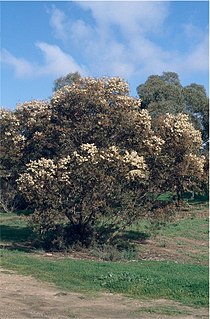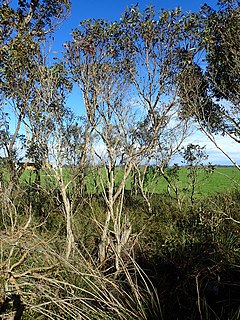
Eucalyptus lansdowneana, commonly known as the crimson mallee or the red-flowered mallee box, is a species of slender stemmed, straggly mallee that is endemic to a restricted area of South Australia. It has rough, fibrous or flaky bark at the base, smooth, grey over creamy-white bark, lance-shaped adult leaves, flower buds in groups of seven, crimson flowers and barrel-shaped fruit.

Eucalyptus socialis, commonly known as the red mallee, or grey mallee, is a species of mallee that is endemic to inland Australia.

Eucalyptus calcicola, commonly known as the Boranup mallee, Harry Butler's mallee or Hamelin Bay mallee, is a mallee that is endemic to a small area in the south-west of Western Australia. It has smooth, pale greenish bark, lance-shaped to curved adult leaves, flower buds in groups of seven or nine, white flowers and ribbed, cup-shaped to hemispherical fruit.

Eucalyptus calycogona, commonly known as the gooseberry mallee or square fruited mallee, is a mallee that is endemic to southern Australia. It has smooth bark, narrow lance-shaped adult leaves, flower buds that are square in cross-section arranged in groups of seven in leaf axils, creamy white, sometimes pink flowers, and fruit that are square in cross-section.

Eucalyptus capillosa, commonly known as wheatbelt wandoo, or mallee wandoo, is a species of tree or mallee that is endemic to Western Australia. It has smooth, grey bark, lance-shaped to elliptic adult leaves, spindle-shaped flower buds in groups of nine to thirteen, white flowers and barrel-shaped to cylindrical fruit.

Eucalyptus effusa, commonly known as rough-barked gimlet, is a species of mallee or small tree that is endemic to Western Australia. It has thin, rough bark on the base of the trunk, smooth bark above, linear to narrow lance-shaped adult leaves, flower buds arranged in groups of seven, white flowers and cup-shaped to conical fruit.
Eucalyptus glomerosa, commonly known as jinjulu, is a species of mallee that is endemic to inland Australia. It has rough, fibrous and flaky bark near the base, smooth bark above, egg-shaped to lance-shaped adult leaves, flower buds usually in groups of seven, cream-coloured flowers and conical to hemispherical fruit. It is mainly found in the Great Victoria Desert of South Australia but also grows in eastern parts of Western Australia.
Eucalyptus gypsophila, also known as the kopi mallee, is a species of mallee that is native to Western Australia and South Australia. It has rough, flaky bark on the lower part of the trunk, smooth light grey bark above, lance-shaped adult leaves, flower buds mostly in groups of between seven and eleven, creamy white flowers and conical to cylindrical fruit.

Eucalyptus kessellii, commonly known as Jerdacuttup mallee, is a species of mallee that is endemic to an area along the south coast of Western Australia. It has very hard, rough bark on the trunk of larger specimens, smooth greyish and brownish bark above, lance-shaped to egg-shaped adult leaves, flower buds in groups of three or seven, creamy white flowers and downturned, conical to cup-shaped fruit.

Eucalyptus leucophloia, commonly known as snappy gum or migum, is a species of small tree or mallee that is endemic to northern Australia. The indigenous Mangarayi and Yangman peoples know the tree as mirndir, the Ngarluma name it as malygan and Yindjibarndi peoples know the tree as majgan. It has smooth, powdery bark, lance-shaped to egg-shaped adult leaves, flower buds usually in groups of seven, white flowers and cup-shaped, barrel-shaped or hemispherical fruit.
Eucalyptus litorea, commonly known as saline mallee, is a species of mallee that is endemic to a small area on the southern coast of Western Australia. It has hard, rough grey bark on the trunk, smooth grey bark above, lance-shaped adult leaves, flower buds in groups of seven, white flowers and cylindrical or barrel-shaped fruit.

Eucalyptus phaenophylla, also known as common southern mallee, is a species of mallee that is endemic to Western Australia. It has smooth bark, linear to narrow lance-shaped or narrow elliptical adult leaves, flower buds in groups of up to thirteen, pale lemon-coloured flowers and barrel-shaped, cylindrical or conical fruit.
Eucalyptus phenax, commonly known as green dumosa mallee or white mallee, is a species of mallee that is endemic to southern Australia. It has smooth bark, lance-shaped adult leaves, flower buds in groups of seven or nine, white flowers and cup-shaped to cylindrical fruit.
Eucalyptus pluricaulis, commonly known as the purple-leaved mallee, is a species of mallee that is endemic to Western Australia. It has smooth bark, dull bluish green, lance-shaped leaves, flower buds in groups of between nine and fifteen, pale yellow flowers and cylindrical to barrel-shaped fruit.
Eucalyptus repullulans, commonly known as chrysoprase mallee, is a species of mallee that is native to arid parts of Western Australia and the far north-west of South Australia. It has smooth bark, lance-shaped adult leaves, flower buds in groups of between seven and thirteen, cream-coloured flowers and cup-shaped, cylindrical or conical fruit.
Eucalyptus vegrandis, commonly known as the Ongerup mallee, is a species of mallee that is endemic to the south-west of Western Australia. It has smooth bark, linear to lance-shaped adult leaves, flower buds in groups of seven, creamy white flowers and cup-shaped or conical fruit.

Eucalyptus adesmophloia is a mallee that is endemic to the south-west of Western Australia. Its fresh bark is grey, the leaves are a glossy dark green, the flowers are white and borne in large groups, and the fruits are conical to hemispherical.
Eucalyptus × balanopelex is a mallee that is endemic to a small area of the south-west of Western Australia. It has smooth bark, broadly lance-shaped adult leaves, flower buds in groups of seven, creamy-white flowers and hemispherical fruit. It is thought to be a hybrid between E. kessellii subsp. eugnosta and E. semiglobosa.

Eucalyptus canescens, commonly known as the Ooldea Range mallee or Beadell's mallee, depending on subspecies, is a species of mallee that is endemic to southern Australia. It has rough bark from the base of the trunk to the thicker branches, smooth bark on the thin branches, egg-shaped to lance-shaped adult leaves, flower buds in groups of between seven and eleven, creamy white flowers and smooth cup-shaped to conical, and sometimes ribbed fruit.
Eucalyptus distuberosa is a species of mallet that is endemic to the south-west of Western Australia. It has smooth dark grey to tan-coloured or creamy white bark, glossy dark green, lance-shaped adult leaves, flower buds in groups of seven, white flowers and cup-shaped to conical fruit.












